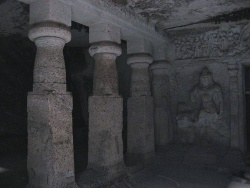Difference between revisions of "Jogeshwari Caves"
| Line 4: | Line 4: | ||
| − | The '''[[Jogeshwari Caves]]''' are some of the earliest [[Hindus]] and [[Buddhist]] [[cave temples]] sculptures located in the {{Wiki|Mumbai}} suburb of Jogeshwari, [[India]] | + | The '''[[Jogeshwari Caves]]''' are some of the earliest [[Hindus]] and [[Buddhist]] [[cave temples]] sculptures located in the {{Wiki|Mumbai}} suburb of Jogeshwari, [[India]]. |
| − | The [[caves]] | + | The [[caves]] date back to 520 to 550 CE. According to historian and [[scholar]] [[Walter Spink]], [[Jogeshwari]] is the earliest major [[Hindu]] {{Wiki|cave}} [[temple]] in [[India]] and (in terms of total length) ' the largest'. |
| − | The [[caves]] are | + | The [[caves]] are located off the [[Western]] Express Highway, and are surrounded by encroachments. |
| − | The {{Wiki|cave}} also has a [[murti]] and footprints of [[goddess]] Jogeshwari (Yogeshwari), whom the area is named after and also considered as a Kuladevi to some [[Gujarati]] [[Brahmins]]. | + | The [[caves]] are used as a [[temple]] by the encroachers. The [[caves]] are classified as endangered as sewage and waste enter the premises. They are also infested with bats. |
| + | |||
| + | The [[caves]] are accessed through a long flight of stairs into the main hall of this cavernous [[space]]. | ||
| + | |||
| + | It has many pillars and a [[Lingam]] at the end. Idols of {{Wiki|Dattatreya}}, [[Hanuman]] and [[Ganesh]] line the walls. | ||
| + | |||
| + | There are also [[relics]] of two doormen. | ||
| + | |||
| + | The {{Wiki|cave}} also has a [[murti]] and footprints of [[goddess]] [[Jogeshwari]] ([[Yogeshwari]]), whom the area is named after and also considered as a [[Kuladevi]] to some [[Gujarati]] [[Brahmins]]. | ||
{{W}} | {{W}} | ||
[[Category:Buddhist Caves]] | [[Category:Buddhist Caves]] | ||
Latest revision as of 23:37, 11 February 2016
The Jogeshwari Caves are some of the earliest Hindus and Buddhist cave temples sculptures located in the Mumbai suburb of Jogeshwari, India.
The caves date back to 520 to 550 CE. According to historian and scholar Walter Spink, Jogeshwari is the earliest major Hindu cave temple in India and (in terms of total length) ' the largest'.
The caves are located off the Western Express Highway, and are surrounded by encroachments.
The caves are used as a temple by the encroachers. The caves are classified as endangered as sewage and waste enter the premises. They are also infested with bats.
The caves are accessed through a long flight of stairs into the main hall of this cavernous space.
It has many pillars and a Lingam at the end. Idols of Dattatreya, Hanuman and Ganesh line the walls.
There are also relics of two doormen.
The cave also has a murti and footprints of goddess Jogeshwari (Yogeshwari), whom the area is named after and also considered as a Kuladevi to some Gujarati Brahmins.
